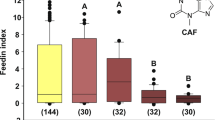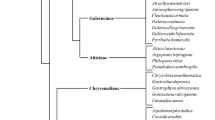Abstract
Taste sensation and food selection by animals can change adaptively in response to experience, for example to redress specific nutrient deficiencies1. We show here, in two species of caterpillar, that infection by lethal parasites alters the taste of specific phytochemicals for the larvae. Given that these compounds are toxic to the parasites and are found in plants eaten by the caterpillars, their changed taste may encourage parasitized caterpillars to increase consumption of plants that provide a biochemical defence against the invaders.
This is a preview of subscription content, access via your institution
Access options
Subscribe to this journal
Receive 51 print issues and online access
$199.00 per year
only $3.90 per issue
Buy this article
- Purchase on Springer Link
- Instant access to full article PDF
Prices may be subject to local taxes which are calculated during checkout

Similar content being viewed by others
References
Simpson, S. J., James, S., Simmonds, M. S. J. & Blaney, W. M. Appetite 17, 141–154 (1991).
Stireman, J. O. & Singer, M. S. Ecology 84, 296–310 (2003).
Nishida, R. Annu. Rev. Entomol. 47, 57–92 (2002).
Bezzerides, A. et al. Proc. Natl Acad. Sci. USA 101, 9029–9032 (2004).
Hartmann, T. et al. J. Chem. Ecol. 30, 229–254 (2004).
Bernays, E. A., Chapman, R. F. & Hartmann, T. J. Comp. Physiol. 188, 715–723 (2002).
Bernays, E. A., Chapman, R. F. & Hartmann, T. Physiol. Entomol. 27, 312–321 (2002).
Bernays, E. A., Chapman, R. F. & Singer, M. S. J. Comp. Physiol. 186, 13–19 (2000).
Bowers, M. D. in Caterpillars: Ecological and Evolutionary Constraints on Foraging (eds Stamp, N. E. & Casey, T. M.) 331–371 (Chapman & Hall, New York, 1993).
Singer, M. S. & Stireman, J. O. Oikos 100, 554–562 (2003).
Singer, M. S., Carriere, Y., Theuring, C. & Hartmann, T. Am. Nat. 164, 423–429 (2004).
Singer, M. S., Rodrigues, D., Stireman, J. O. & Carriere, Y. Ecology 85, 2747–2753 (2004).
Rothschild, M. Biol. J. Linn. Soc. 12, 305–326 (1979).
Author information
Authors and Affiliations
Corresponding author
Ethics declarations
Competing interests
The authors declare no competing financial interests.
Supplementary information
Rights and permissions
About this article
Cite this article
Bernays, E., Singer, M. Taste alteration and endoparasites. Nature 436, 476 (2005). https://doi.org/10.1038/436476a
Published:
Issue Date:
DOI: https://doi.org/10.1038/436476a
This article is cited by
-
A mixed diet of toxic plants enables increased feeding and anti-predator defense by an insect herbivore
Oecologia (2014)
-
Plant secondary compounds as complementary resources: are they always complementary?
Oecologia (2013)
-
Complex effects of parasitoids on pharmacophagy and diet choice of a polyphagous caterpillar
Oecologia (2011)
-
Experience-based behavioral and chemosensory changes in the generalist insect herbivore Helicoverpa armigera exposed to two deterrent plant chemicals
Journal of Comparative Physiology A (2010)
-
Consumption of a nectar alkaloid reduces pathogen load in bumble bees
Oecologia (2010)
Comments
By submitting a comment you agree to abide by our Terms and Community Guidelines. If you find something abusive or that does not comply with our terms or guidelines please flag it as inappropriate.



